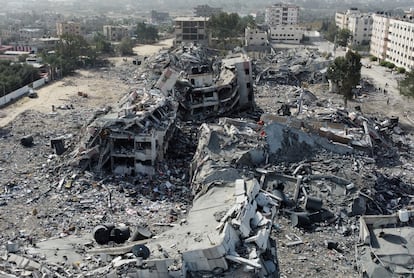Obstacles to extending Gaza ceasefire: humanitarian aid, selection of prisoners and visits to hostages
Mediators are attempting to extend the truce between Israel and Hamas despite mutual accusations and isolated episodes of non-compliance

The mediators of the pact between Israel and Hamas are seeking to extend the ceasefire in Gaza but face several obstacles. Since the cessation of hostilities came into effect last Friday, mutual accusations of non-compliance and a few isolated episodes have failed to derail the agreement: four days of truce in which Hamas is gradually handing over 50 Israeli hostages held captive in Gaza in exchange for Israel releasing 150 Palestinian prisoners and allowing more humanitarian aid to enter the Strip from Egypt. Among the incidents that have threatened the ceasefire are the death on Saturday of a Gazan farmer by Israeli fire (the first fatality during the truce), the shooting of Palestinians trying to return to their homes in the north of the Strip, and the launching of a rocket from Gaza 15 minutes after the ceasefire began. But it is not the same to unblock an exchange of hostages and prisoners that is already underway — which a diplomatic frenzy across three continents resolved on Saturday — as it is to agree on an extension by closing the loopholes that have been emerging. The agreement expires early Tuesday morning and is designed to last up to five more days if both sides continue to meet their obligations. After that, as Israel has made clear, the war will resume.
One of the elements of contention is the entry of humanitarian aid into the Strip. Following the Hamas attacks on October 7, Israel put Gaza under a complete blockade: no water, no electricity, no fuel. Later, it agreed to allow the entry of a minimal amount of humanitarian aid through Egypt, and only for southern Gaza, where almost the entire population is concentrated: 80% of the 2.3 million inhabitants of Gaza have been forcibly displaced, according to United Nations data. Under the agreement the number of trucks entering has increased to 200 per day and extended access to the entire Strip, although this is still 300 trucks per day fewer than before October 7.
On Friday, the first day of the agreement, 200 vehicles arrived at the Rafah border crossing, but only 137 were unloaded for logistical reasons, according to the UN Office for the Coordination of Humanitarian Affairs (OCHA). On Saturday, 187 were allowed through. On each of those days, 129,000 liters of fuel — needed to run hospitals, desalination plants and the water treatment system — and four truckloads of cooking gas were also delivered, according to OCHA.
On Saturday, Hamas halted the handover of hostages, accusing Israel of breaching the humanitarian aid pact. Its spokesman, Osama Hamdan, said only 65 trucks, carrying food, water, medicine, and tents, but no fuel, had reached the north of the Strip, which has been virtually reduced to rubble after the Israeli army ordered the evacuation of the population and where the ground invasion has been focused. “It’s less than half of what was agreed,” Hamdan noted. Israel interpreted it as merely a psychological warfare strategy to exploit the importance the country attaches to the return of the hostages. Qatar and Egypt, the two main mediators, had to intervene urgently, while an official Israeli source threatened anonymously to resume the bombing of Gaza if the hostages did not set foot on Israeli soil before midnight.
On Sunday, the Palestinian Red Crescent reported that, for the first time, 50 Egyptian trucks had gone directly from the Rafah crossing into northern Gaza, including to the capital of the Strip, through a military checkpoint manned by Israeli troops.
This crossing has also allowed those who were stranded in Egypt by the outbreak of the war on October 7 and wanted to be reunited with their families to return home. Cairo permitted this for the first time on Friday. The ceasefire has also facilitated the transfer of patients to hospitals in southern Gaza from the north, where virtually all medical facilities are inactive due to a combination of lack of resources and Israeli raids and shelling. The head of the World Health Organization, Tedros Adhanom Ghebreyesus, reported the evacuation on Friday of 22 patients from the Al Ahli medical center to the European hospital in the southern city of Khan Younis, which is already treating twice its capacity.

Hostage lists
Another source of disagreement are the hostage lists. Israel accuses Hamas of reneging on an agreement that families would not be separated, as those being released are women and minors. On Saturday Qatar, which brokered the deal, received complaints from Hamas that the agreed principle of releasing the longest-serving prisoners first was not being applied. “Just as Hamas decides who to release from the list at each stage, we decide which Palestinian security prisoners to release,” an official Israeli source told Channel 12 television.
U.S. Secretary of State Antony Blinken called Egyptian Foreign Minister Sameh Shoukry on Sunday, who stressed the “need to make every effort” to implement the humanitarian aid part of the agreement, according to an Egyptian diplomatic statement. On Saturday, U.S. President Joe Biden had telephoned the emir of Qatar, Tamim bin Hamad Al Thani, to unblock the situation. The emirate — where part of the Hamas leadership resides and which has been funding the movement for years with Israel’s approval — sent the first delegation from another country to Gaza since October 7 headed by its Minister of State Cooperation Lolwah Al Jater.
Visits to the hostages by the Red Cross is an issue that has also been attracting more and more protesters in Israel. At a press conference Wednesday, Prime Minister Benjamin Netanyahu read the section of the agreement that contains that promise in what was largely a point-scoring exercise. In reality, it is a moot point. The Red Cross can only access the hostages with the agreement of both parties. And — no matter how many assurances it receives — Hamas is unwilling to provide the slightest clue as to where the hostages are being held, with Gaza controlled from the sky by Israeli surveillance drones and thousands of soldiers on the ground in the Strip.
Sign up for our weekly newsletter to get more English-language news coverage from EL PAÍS USA Edition
Tu suscripción se está usando en otro dispositivo
¿Quieres añadir otro usuario a tu suscripción?
Si continúas leyendo en este dispositivo, no se podrá leer en el otro.
FlechaTu suscripción se está usando en otro dispositivo y solo puedes acceder a EL PAÍS desde un dispositivo a la vez.
Si quieres compartir tu cuenta, cambia tu suscripción a la modalidad Premium, así podrás añadir otro usuario. Cada uno accederá con su propia cuenta de email, lo que os permitirá personalizar vuestra experiencia en EL PAÍS.
¿Tienes una suscripción de empresa? Accede aquí para contratar más cuentas.
En el caso de no saber quién está usando tu cuenta, te recomendamos cambiar tu contraseña aquí.
Si decides continuar compartiendo tu cuenta, este mensaje se mostrará en tu dispositivo y en el de la otra persona que está usando tu cuenta de forma indefinida, afectando a tu experiencia de lectura. Puedes consultar aquí los términos y condiciones de la suscripción digital.
More information
Archived In
Últimas noticias
David Bowie, the galactic thinker who encouraged us to break new ground
John Berger and the loss of rural culture
From police officer to bloodthirsty kidnapper: Terror in Mexico during the years of ‘The Ear Chopper’
Alain Aspect, Nobel laureate in physics: ‘Einstein was so smart that he would have had to recognize quantum entanglement’
Most viewed
- David King, chemist: ‘There are scientists studying how to cool the planet; nobody should stop these experiments from happening’
- Reinhard Genzel, Nobel laureate in physics: ‘One-minute videos will never give you the truth’
- Oona Chaplin: ‘I told James Cameron that I was living in a treehouse and starting a permaculture project with a friend’
- Sinaloa Cartel war is taking its toll on Los Chapitos
- Mexico completes its trade shift with the entry into force of tariffs on China and countries without trade agreements











































